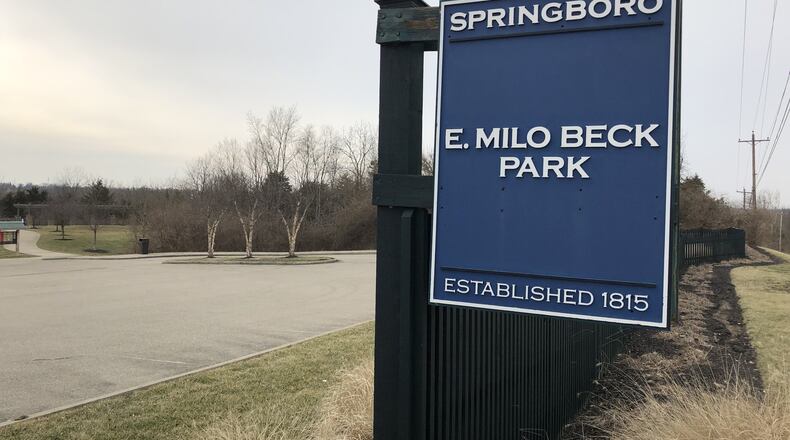The teenager had been reported missing from her Florida home five months earlier.
The girl is back home, healing from physical and emotional wounds, her mother said in a telephone interview.
“She’s in a stage where she’s not talking much about it,” said the mother, who is not being identified to protect the victim’s identity. “She needs a lot of treatment.”
The teen told Springboro police her ordeal began when she was forced to leave Orlando in August with an ex-boyfriend and ended when she was found on Jan. 16 at E. Milo Beck Park in Springboro with a 24-year-old South American man whom she met online.
“You have so little of the story when you encounter the victim,” said Benjamin Glassman, U.S. Attorney for the Southern District of Ohio.
Human-trafficking cases can cover multiple law enforcement jurisdictions, state and even national boundaries, and they are labor-intensive and time-consuming, Glassman and other experts interviewed for this story said.
Glassman expects trafficking cases to grow as use of digital technology increases.
According to the Ohio Attorney General’s Office, law enforcement reported 242 human trafficking investigations leading to 80 arrests and 61 successful criminal convictions in the state in 2018.
A host of local, state and federal authorities continues to work to heighten awareness of and combat criminal networks engaged in what the FBI calls a “modern form of slavery.”
‘We don’t see that every day’
Springboro Detective Terry Dunkel said the teen girl marked the first human trafficking case he had been involved with in 18 years with the police department in the affluent Dayton suburb, just south of the Warren County line.
“Springboro, we don’t see that every day,” he said.
Human trafficking is “believed to be the third-largest criminal activity in the world,” according to the FBI. “Here in this country, people are being bought, sold, and smuggled like modern-day slaves, often beaten, starved, and forced to work as prostitutes or to take jobs as migrant, domestic, restaurant or factory workers with little or no pay.”
The Springboro case was turned over to an FBI task force formed with Cincinnati police to handle human trafficking cases, according to Springboro police.
“These cases are so complex,” Dunkel said.
The 5-foot, 4-inch, 95-pound girl found in the park was vulnerable, having previously run away from home after being abused by her father, according to her mother, a description consistent with national statistics on human trafficking victims.
The girl told Springboro police an ex-boyfriend forced her into his car, raped her and drove her to Cincinnati in August. The ex-boyfriend has since returned to Orlando or traveled to Puerto Rico, according to the girl’s statement to police.
Orlando police did not respond to queries about the case, which was still listed on the department’s website, along with the victim’s photo, until they were advised by this reporter she had been found.
FBI public information officer Todd Lindgren declined to comment for this story, typical of the FBI on pending investigations.
Lured through the Internet
Lukas Serrano, 24, is charged with contributing to the Orlando girl’s delinquency. Neither he nor anyone else has been charged with human or child sex trafficking offenses.
Serrano said he drove the teen from Cincinnati to Indiana and back after meeting her on Badoo, a dating application where her profile said that “she was looking for smoking buddies,” according to the Springboro police incident report.
A counter at badoo.com indicates more than 416 million “have already jumped in.”
“Badoo is the largest social discovery network in the world. Our mission is to provide the best technology for people to meet, because happiness is better shared,” according to its website.
Badoo did not respond to a request for comment.
Glassman said child sex trafficking victims are often “initially lured through the Internet” or apps like Badoo. Because people rely more and more on the Internet and digital devices, he predicted human trafficking, particularly child sex trafficking, would be a growing problem.
Victims sometimes are romantically attached to the traffickers, Glassman said.
“That’s not a person that really wants to cooperate,” he said.
Serrano reportedly told Springboro police that he paid for a hotel room in Springdale, a Cincinnati-area suburb, where they stayed the night - but did not have sex. After a meal at a Chipotle in Monroe, he said they went to the Springboro park, where they were then detained.
The girl was held for more than two weeks in the Warren County Juvenile Detention Center before being flown back to Orlando on Feb. 5, according to court records and officials.
The Florida Department of Juvenile Justice, which took custody of the girl, declined to comment.
Serrano, of Colombia, was released to his uncle in Lebanon, according to the report.
Serrano told police he was planning to travel next to France before returning home to Colombia. He is scheduled to return to the juvenile court in Lebanon on March 18.
Serrano’s lawyer did not respond to requests for comment.
‘In every single state’
According to the National Center for Missing or Exploited Children, human trafficking has been reported “in every single U.S. state.”
In 2017, one in seven of about 25,000 missing or exploited juveniles reported to the center “were likely victims of child sex trafficking. Of those, 88 percent were in the care of social services when they went missing,” according to the center’s website. Average age: 15.
Glassman said child sex trafficking was the most common type of human trafficking case handled by his office, which prosecutes federal criminal cases in Ohio’s lower 48 counties.
In response to a media request for an indication of the caseload in the Southern District of Ohio, Jennifer Thornton, the public information officer in Glassman’s office, cited three cases in 2018 and so far this year “that may have involved human trafficking allegations or a confirmed victim of human trafficking.”
Court records indicate two cases stem from the same investigation involving two men charged with child sex trafficking. The case began as a child pornography investigation after police were called to a suburban Cincinnati hotel about a “distraught” 16-year-old girl, according to online court records.
Steven E. Ritter and Eduard Sarkisov both face sex trafficking of children by force, fraud or coercion charges.
Ritter was charged after the FBI came to the hotel room in Sharonville, where Ritter said he had been living since Thanksgiving 2016, according to an agent’s complaint.
According to Sarkisov’s criminal complaint, the Mason resident was charged after images of him with the alleged victim and an “adult female” were found on Ritter’s cellphone. Sarkisov’s identity was confirmed with a 2001 Warren County jail booking photo, and through surveillance outside a business he managed in Sharonville, according to court records.
In the third case cited, Gordon E. Hill Jr. of Columbus is scheduled for sentencing on April 4 in U.S. District Court in Columbus on three counts of sexual exploitation of children.
In that case, built by the Central Ohio Human Trafficking Task Force, “facts were discovered as a result of an investigation into human trafficking activities,” according to an Immigration and Customs Enforcement, Homeland Security agent’s complaint.
In January 2017, the task force also received information that Hill and the 16-year-old alleged victim “had recruited two additional minor females to engage in these activities,” according to the complaint.
‘Protection of the most vulnerable’
Sometimes, Glassman said, suspects identified through child sex trafficking investigations are convicted of other charges. In this way, victims in difficult cases can be spared from having to testify, while those responsible are ” put away for a long time,” he said.
Glassman said continued training and cooperation were the keys to combating human and child sex trafficking.
He pointed to FBI efforts and local initiatives, such as a working group set up by police in Blue Ash, a Cincinnati suburb, focused on techniques effective in combating human trafficking.
“The protection of the most vulnerable is and remains a very high priority,” Glassman said. “We certainly do and will continue to devote the resources, whatever resources we can, to prosecute any cases we can.”
The Ohio Attorney General’s Office trains local law enforcement to identify high-risk youths and frequent runaways.
The office also provides funding to victims through agencies that serve those victimized by or susceptible to human trafficking.
Last month, Ohio Attorney General Dave Yost announced a program providing $10,000 grants to nonprofit agencies aiding human trafficking victims to pay for the removal of tattoos or other markings used to “brand them by pimps, drug dealers or gangs.”
“The journey of a survivor out of slavery and addiction and trauma is hard enough without a permanent reminder that is literally part of your skin,” Yost in a press release. “These grants will enable women to leave behind the brand that identified them as someone else’s property.”
About the Author

